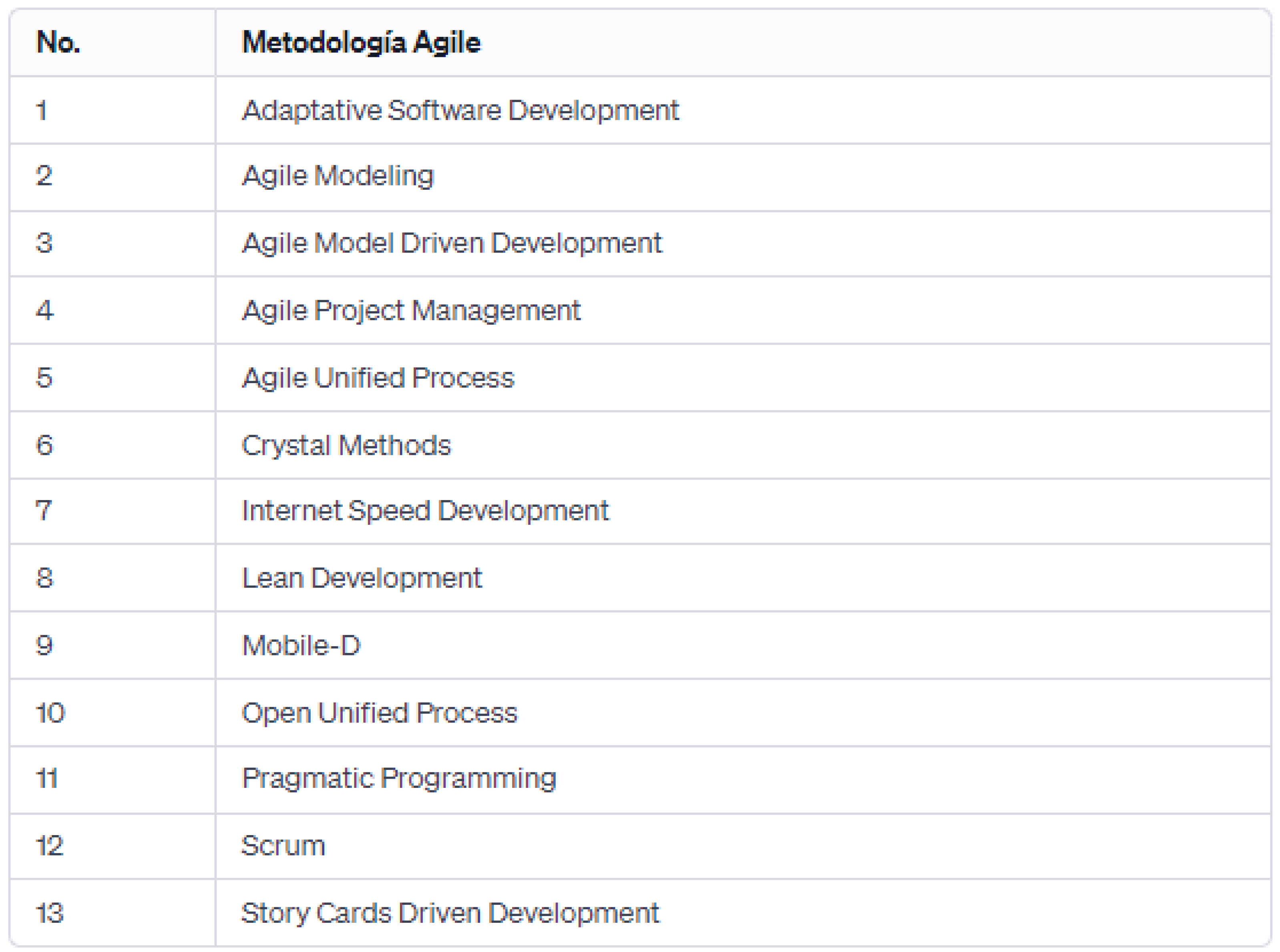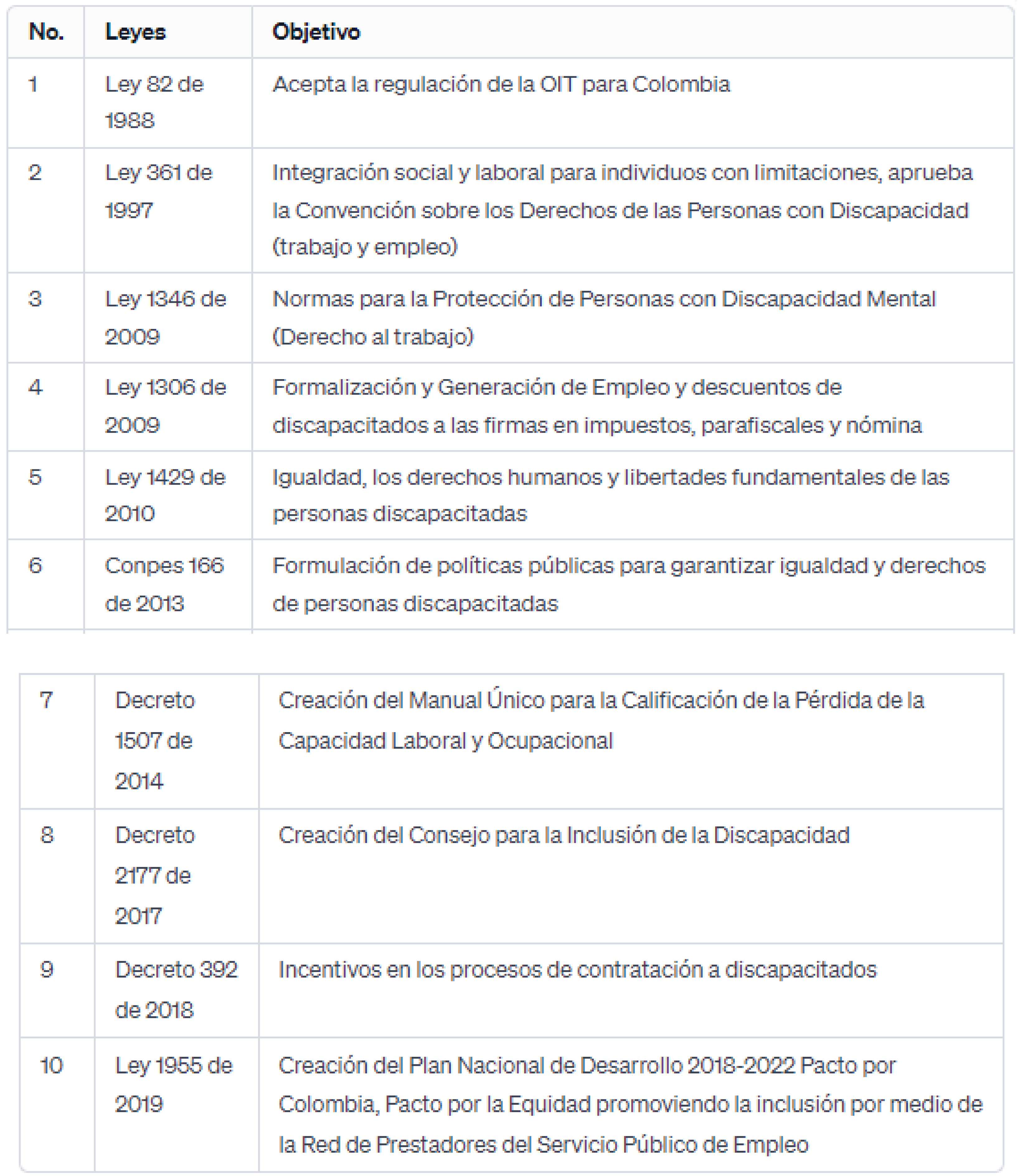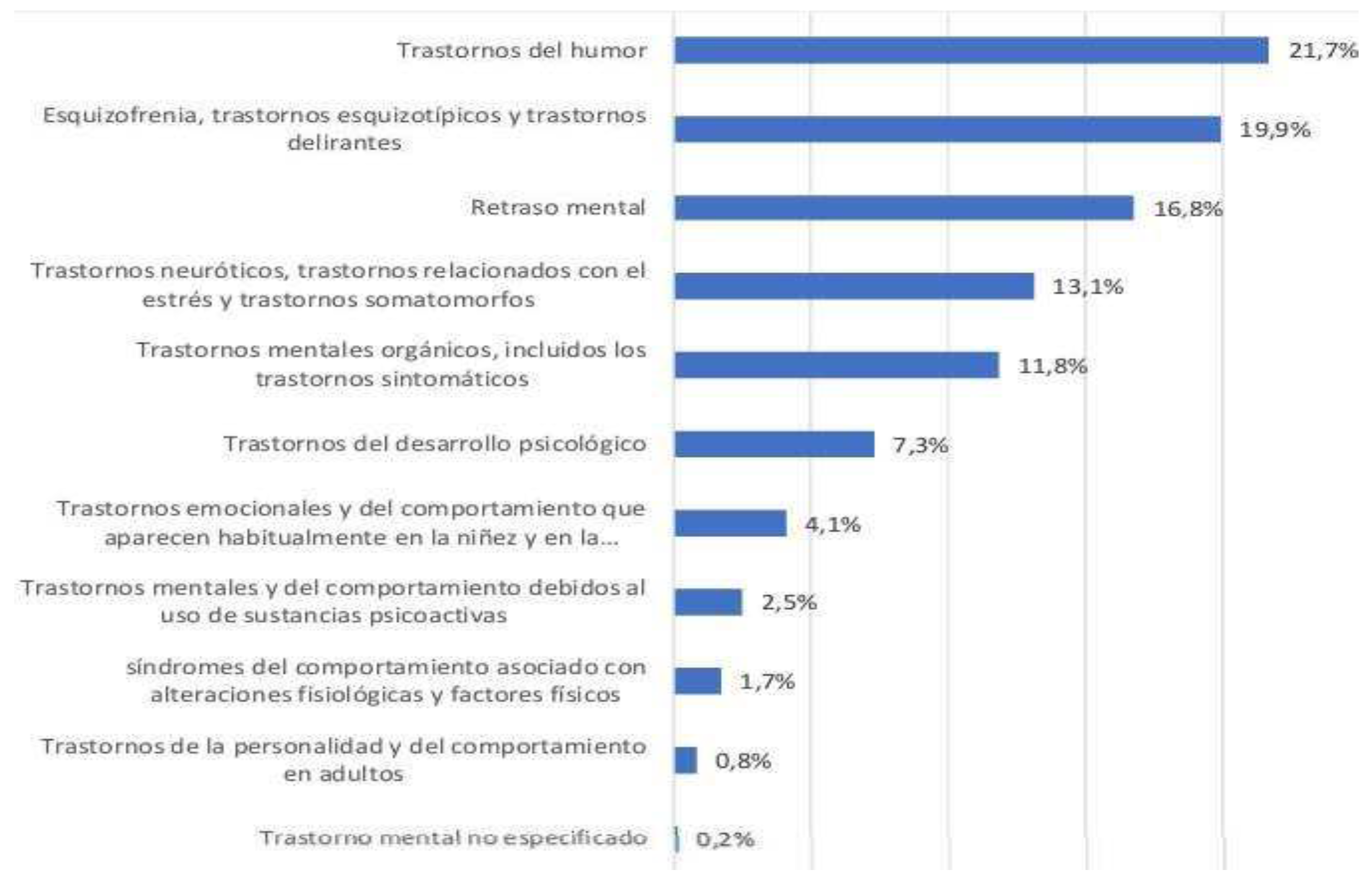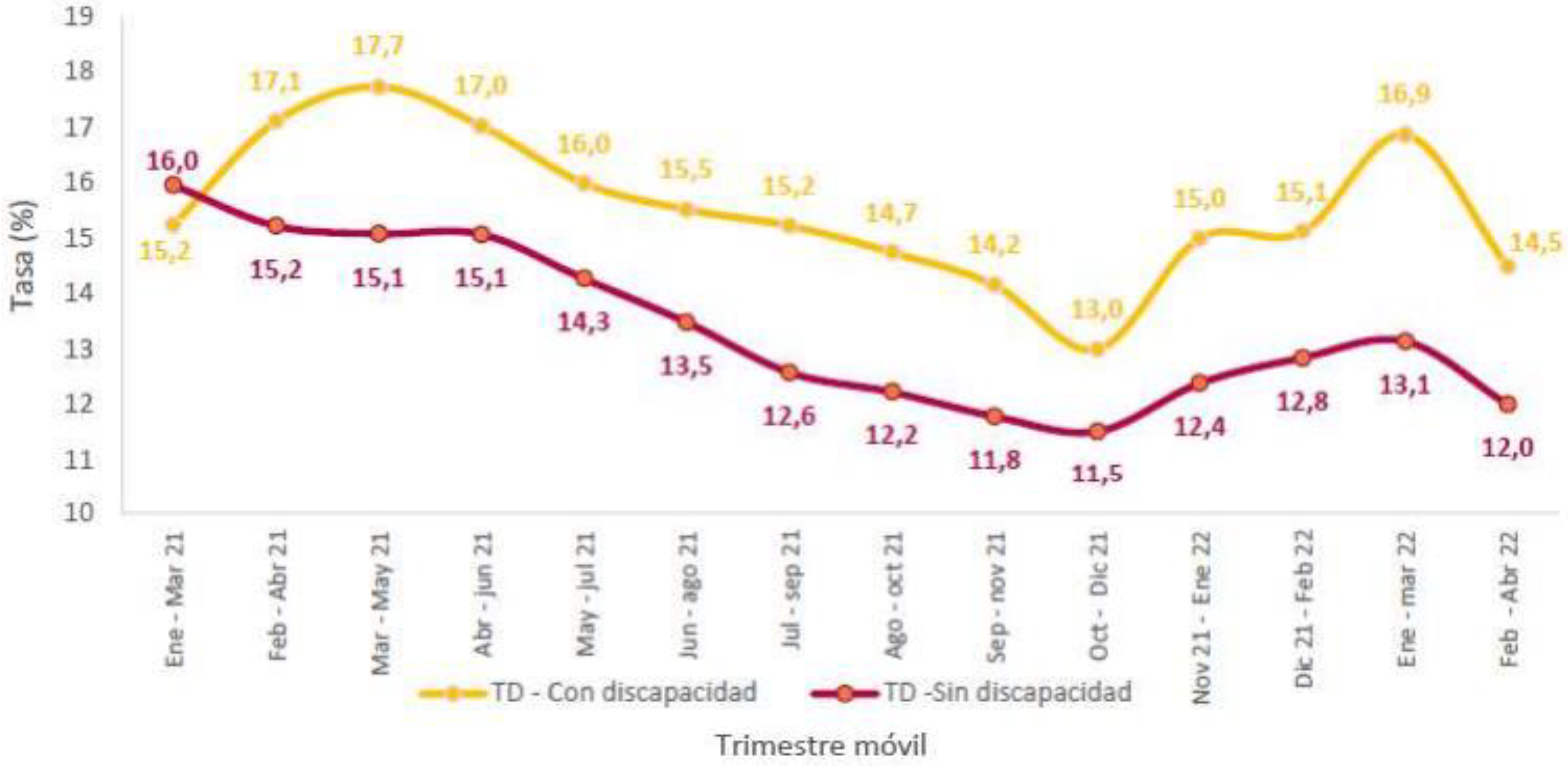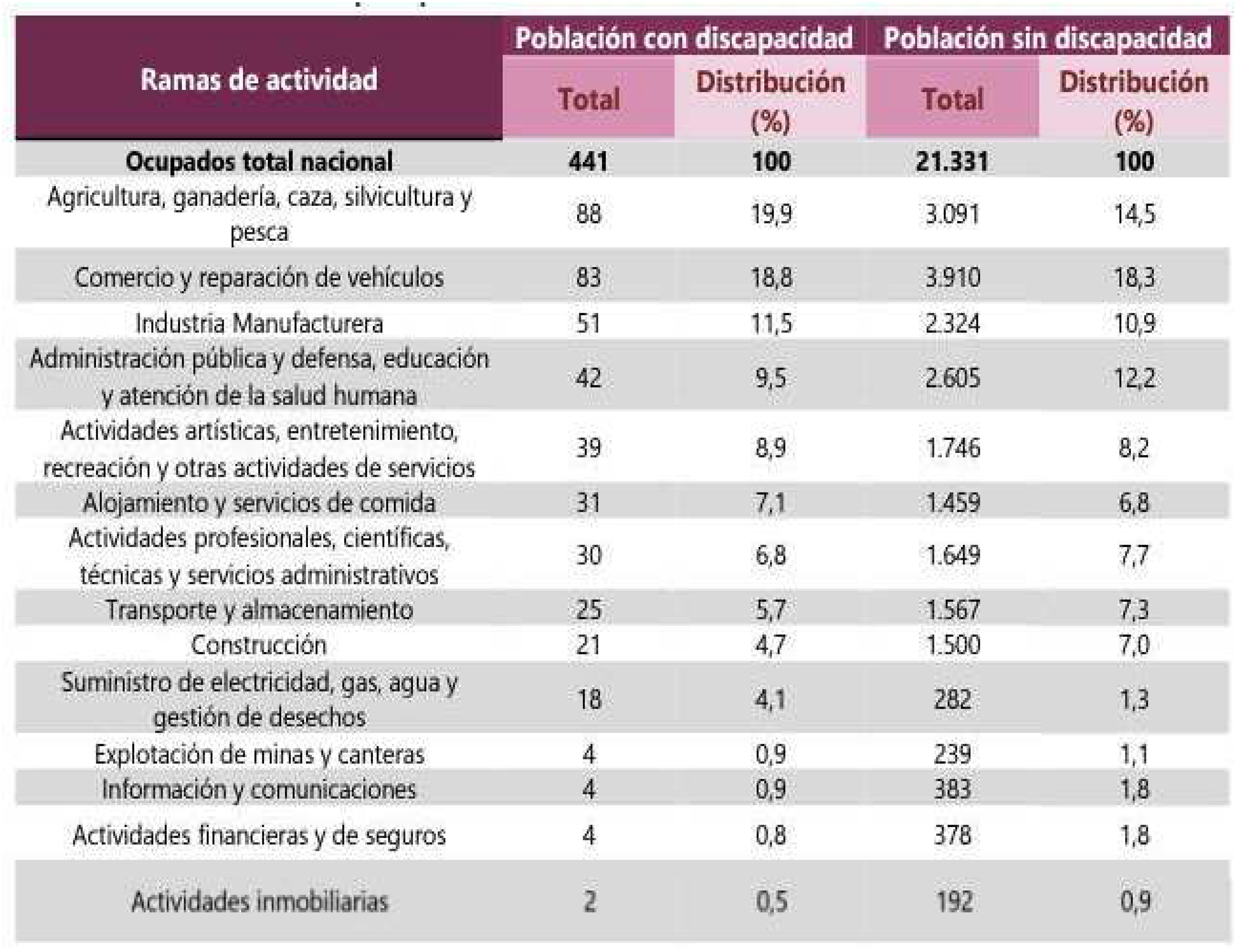1. Introduction
In the global context, persons with disabilities have gained recognition through laws and rights granted by international organizations such as the World Health Organization (WHO). These provisions seek to integrate persons with disabilities, enabling them to participate fully in society. However, it is crucial to consider diversity in the type and degree of disability, ranging from intellectual to physical disabilities. Despite facing barriers to learning and participation, people with disabilities maintain active and participatory lives (Olto & García, 2022).
However, the reality for these people has been social exclusion, facing discrimination in their daily lives. Globally, more than one billion people have some form of disability, and this number is projected to double to two billion (Olney & Martínez Donoso, 2021).
In Colombia, despite having laws such as Law 1145 of 2007, which guarantees fundamental rights, Law 1429 of 2010, which formalizes the generation of employment, and Law 1955 of 2019, which promotes labor inclusion, challenges persist for the full participation of people with disabilities in the workplace.
This study proposes the application of Industry 4.0 technologies as a tool to improve the quality of life and employability of individuals with mild intellectual disabilities, specifically in tasks carried out in refrigerated rooms.
Using the Scrum development framework, a prototype mobile application will be developed, which seeks to reduce existing barriers in labor participation, minimizing occupational risks and facilitating administrative management by employers. This prototype will be an initial step in the construction of innovative solutions to address this complex and relevant problem.
The structured approach with which the solution of the problem will be approached, allows an exhaustive analysis of each aspect of the development of the application, from the conceptualization to the evaluation of the prototype, providing a complete vision of the project and its implications.
The main objective of this second phase of the research project is to present the design of a mobile application aimed at improving the work management of people with IDD, with a special focus on specific work environments, such as refrigerated rooms. In addition, it seeks to integrate agile methodologies, in particular Scrum, and Industry 4.0 technologies to provide an adaptive and efficient solution.
Specific objectives include:
Explore the Scrum methodology and its application in the development of mobile applications for people with IDL.
Analyze Colombian regulations related to the labor inclusion of people with disabilities, with emphasis on DIL.
Present the modules and key features of the proposed mobile application, called DILSA (Disability Intellectual Light Solution App).
Evaluate the feasibility and potential benefits of the application in the prevention of occupational risks and the improvement of performance in specific environments.
2. DIL Project Management with Agile Methodologies
The effective management of projects aimed at the labour inclusion of people with Mild Intellectual Disabilities (LDD) requires a dynamic and adaptive approach. In this context, the application of agile methodologies, especially Scrum, is presented as a key strategy for the successful development of technological solutions. This section will address the evolution of mobile app development methodologies, the fundamental importance of agile methodologies, and a detailed overview of Scrum.
2.1. Agile and Scrum Methodologies
2.1.1. Evolution of Mobile Application Development Methodologies
Mobile app development has undergone significant evolution in recent years. From traditional approaches to the adoption of agile methodologies, this section explores how development strategies have evolved to adapt to changing market demands and the specific needs of DIL users.
Table 1.
Different agile methodologies.
Table 1.
Different agile methodologies.
2.1.2. Importance of Agile Methodologies
Agile methodologies have proven to be crucial in the realm of mobile app development, allowing for faster response to change, greater flexibility in planning, and incremental product delivery, which makes these methodologies especially relevant when addressing projects that involve the labor inclusion of people with IDL.
2.1.3. Description of Scrum
Scrum was selected because it is characterized by roles and practices that produce dynamism in the project within independent (self-organized) work teams and with fluid communication. In addition, the project cycle is iterative and incremental, meaning that the project is released periodically, and each delivery is a functional increment.
The Sprints, which are designed in four monthly periods, present project progress and are managed internally through daily meetings, where the progress of each Sprint is planned and reviewed. That corresponds to the functionality of the prototype that derives from the Product Backlog focused on the requirements or user stories.
Scrum, as an agile methodology, defines specific roles that play a crucial role in the success of the project. The main roles in Scrum will be detailed, such as the Master Scrum, the Product Owner, and the Development Team, which are effectively integrated into the project focused on the labor inclusion of people with DIL.
2.1.4. Mobile development.
On the other hand, mobile devices have been an important part of human beings, their use being more and more common; their evolution has allowed the development of more complex applications complementing the daily lives of individuals. Since the appearance of the iPhone in 2007 that revolutionized mobile phones by running mobile applications and providing access to and from the internet, (Martínez Espinoza, 2020).
It should be added that these mobile devices contain an architectural logical basis similar a the of any computer con one operating system Like BAherself On top of which multiple applications can be installed for the user's convenience, (Villalobos Abarca, 2015 p. 475). In other words, just like in web development and/or desk, in Mobile software development methodologies are employed with the aim of of Optimize resources and ensure quality software or application, therefore herself chooses to choose agile methodologies due to their adaptive characteristics that emerge throughout the project (Molina Ríos, Honores Tapia, Pedreira-Souto, & Pardo León, 2021).
Considering that mobile devices are integrated with, Industry 4.0 And they're Especially related the with connectivity and interaction between machines and humans, it is expected achieve the transformation dthe design, development, operation and the service of products and production systems, (Diana Velásquez, Alba López, & Palencia Pérez, 2019 p. 7), this means, that individuals with DIL, I canan interact with machines, in this case with mobile devices.
Given the above, Industry 4.0 allows us to use different components, and due to the connectivity between devices, the research will focus on the Internet of Things (IoT), which is based on the connection of everyday objects to the Internet, allowing the exchange, aggregation, and processing of information about their physical environment, to provide value-added services to end users. (Barrio Andrés, 2018 p.19); however, these solutions exclude people with IDL in certain fields of work, since for the organizational provider, including them in their production processes in refrigerated rooms is complicated and time-consuming.
For the development of a software, in this case an app, the initial step of this phase is the creation of the design of a functional prototype that will improve the understanding of what is going to be developed according to the requirements (Pressman, 2010); on the other hand, according to (Sommerville, 2011) prototypes allow to test design alternatives. Obtaining more information about the problem with its possible solutions, having the costs controlled and ultimately, allows those interested in the system to experience, at an early stage, the entire process and the future behavior of the app.
2.2. Mild Intellectual Disability (DIL)
The World Health Organization (WHO) provides a specific definition of Mild Intellectual Disability, which highlights the key aspects that influence job adaptation and inclusion of individuals with IDD.
2.2.1. Features and Classifications
The characteristics and classifications associated with DIL have a direct impact on adaptation in the work environment. These characteristicsare explored, highlighting the importance of understanding individual needs when designing technology solutions.
According to Antequera Maldonado (2008) in his study, the characteristics of people with DIL are the following:
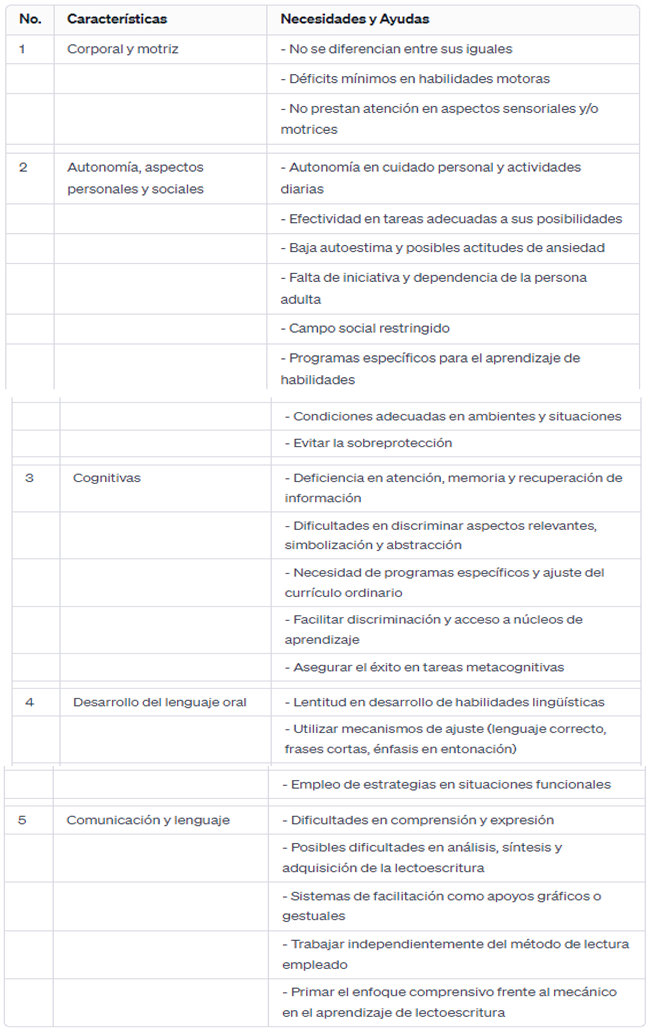
2.3. Colombian Regulations
2.3.1. Laws Related to Labor Inclusion
Colombia has specific regulations that address the labor inclusion of people with disabilities. An overview of the relevant laws and how they influence the creation of technological solutions for the inclusion of people with IDL is provided.
Table 3.
Inclusive Laws. Own source.
Table 3.
Inclusive Laws. Own source.
2.3.2. Focus on DIL
With a specific focus on Mild Intellectual Disability, it analyzes how Colombian laws address the needs of this group of people in the workplace. The importance of legislation in promoting equality and equity is highlighted.
It should be noted that in the Colombian context, about 1.3 million people live with a disability, and approximately 16.8% of them experience some type of mild intellectual disability (MINSALUD, 2020), see
Figure 1. This reality is reflected in employment figures, where only 27% of people with disabilities worked in paid activities, evidencing significant gaps compared to people without disabilities (Corona Foundation, ANDI Foundation and Alliances for Reconciliation Program, 2019).
However, people with some type of disability can work in different fields, as can be seen in
Figure 3; in which the first three activities are Agriculture, livestock, hunting, forestry and fishing which represents 19.9%, in second place, is Trade and vehicle repair with 18.8% followed by Manufacturing Industries 11.5%.
Figure 2.
DANE and GEIH (2022)
Therefore, since Colombia is in the task of increasing the inclusion of people with IDL in all areas, and taking into account the existence of laws such as Law 1145 of 2007 that guarantees their fundamental rights, Law 1429 of 2010 that formalizes the generation of Employment, Law 1955 of 2019 that promotes labor inclusion through the Network of Public Employment Service Providers, the present work focuses on cognitive or intellectual disability with skills to carry out daily work routines (Mintrabajo, 2021; Arco Tirado and Fernández Castillo, 2004).
For this reason, by implementing elements of industries 4.0, in order to improve the quality of life through employability in the work in refrigerated rooms for individuals with some DIL and having the knowledge that they are functional individuals with certain limitations, together with Colombian national laws that include them at all levels in society. A prototype or mockup of an App is developed through the Scrum methodology, which allows and minimizes the barriers in labor participation in this trade, as well as reducing labor risks and facilitating the employer an increase in the management of these operations.
3. Design of the DILSA (Disability Intellectual Light Solution App) Mobile Application
The design of the DILSA mobile application marks a crucial phase in the project, focusing on the creation of a robust prototype that aligns with the specific needs of people with Mild Intellectual Disability (MID). This section details the tools and technologies used, as well as the methodology applied in the design process.
3.1. DILSA Key Technologies and Modules
The development of DILSA involves the integration of various technologies and fundamental modules to ensure its effectiveness in the work environment. The following elements will be addressed:
3.1.1. Facial Recognition
The facial recognition module is presented as a key tool for user authentication and security. Self-learning AI technologies used to facilitate facial recognition and their specific application in the context of DIL will be explored.
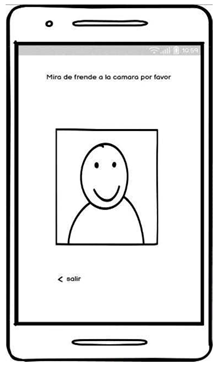
3.1.2. RFID (Radio Frequency) Technology
This module focuses on localization, temperature monitoring, and alarm generation, especially in refrigerated environments. The implementation of RFID technology and its contribution to the safety and well-being of people with IDD in specific work environments will be examined.

3.1.3. Pictogram Repository
The pictogram repository is essential for communication and understanding of work activities. A sequence of drawings will describe the activity that must be carried out through the transmission of explanatory messages to people with IDL, facilitating their participation in the work environment.
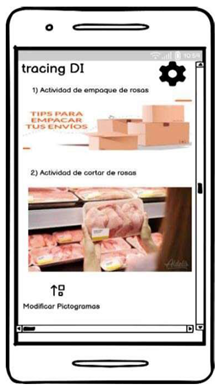
3.1.4. Emergency Button
This module allows people with DIL to request help easily and quickly. The functionality and importance of this emergency button in the app will be discussed, ensuring safety and prompt assistance when needed.
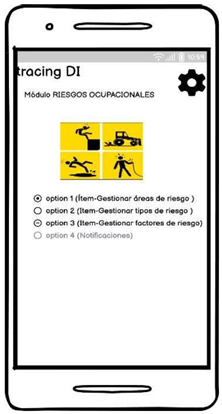
3.1.5. Occupational Safety and Health Module
The occupational health and safety module focuses on reporting on risks and hazards through pictograms. The functionalities that provide crucial information for decision-making and the prevention of occupational risks will be detailed.
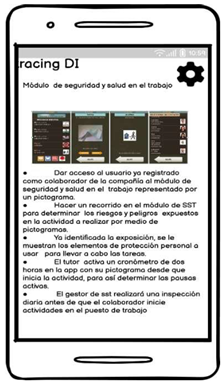
3.2. Design Methodology: Scrum Applied to Prototyping
The application of Scrum in the design phase is essential to ensure adaptability and incremental delivery of key functionalities. It will be described how Scrum is applied in meetings with stakeholders and psychologists, obtaining the minimum requirements and dividing the tasks to generate the design by sections of the prototype.
3.3. DILSA Prototyping and Design Results
The prototyping process culminates with the delivery of each functional module in the Balsamiq program. The results obtained are presented, highlighting the user interface, navigability and effective integration of the modules designed to meet the specific needs of people with IDL.
3.4. Evaluation of Functional and Non-Functional Requirements
A detailed assessment of the functional and non-functional requirements defined for DILSA is carried out. Tables summarizing these requirements are presented, ensuring the consistency and viability of the application in terms of usability, security, and performance.
This module lays the groundwork for the development phase of the DILSA mobile app, demonstrating the applicability of Scrum in inclusive project management and presenting a robust prototype that addresses the specific needs of people with DIL in specific work environments.
4. Development Methodology
This section describes in detail the key stages of the development methodology used to carry out the project, focusing on the prototyping of the DILSA mobile application.
4.1. Documentary Analysis
The documentary analysis phase played a crucial role in identifying best practices and regulations related to the labor inclusion of people with Mild Intellectual Disabilities (MIDs). A comprehensive search was conducted nationally and internationally, addressing labor inclusion, especially in specific roles, such as operating in refrigerated room environments. The literature review provided key information on the adaptation of work environments and existing technologies that could improve the employability and well-being of people with IDL in such settings.
4.2. Application of Scrum Methodology
The Scrum methodology was applied comprehensively for the management of the project, from the elicitation of requirements to the delivery of the final prototype. The main stages included:
Elicitation Meetings with Stakeholders: Through meetings with end-users, psychologists, and other experts in the field, the minimum requirements needed for the application were identified.
Scrum Team and Division of Tasks: With the participation of the Scrum Team, tasks were divided into modules, ensuring an efficient distribution of responsibilities and competencies.
Iterative design: The Scrum methodology allowed for an iterative approach to prototype design. Each module was designed in sections, and incremental deliverables were made for continuous feedback.
4.3. Functional and Non-Functional Requirements
Functional and non-functional requirements were identified and documented in collaboration with the client and other stakeholders.
Table 5 presents a detailed list of functional requirements, while
Table 6 and
Table 7 describe non-functional requirements and description of application development, respectively. These requirements laid the foundation for the design and development of the prototype.
4.4. Prototype development with Balsamiq
The development of the prototype was carried out using the Balsamiq tool, which allows for the rapid creation of user interfaces and interactive prototypes. The images and tables provided during the design phase were used to guide the implementation of the prototype.
Iteration and Tweaking: The application of Scrum allowed for continuous iterations and tweaks based on the feedback received. Each module was developed separately, then integrated to form the complete prototype.
Prototype Validation: Usability and functionality tests were performed to validate the prototype with the end user, the Scrum team, and stakeholders. It ensured that all functional and non-functional requirements were addressed effectively.
4.5. Prototype Results and Evaluation
After the implementation of the prototype in Balsamiq, the results obtained are evaluated. The tool allowed for a clear visual representation of the user interface and sequence of actions. The following are the main aspects evaluated:
Usability: The ease of use of the interface was evaluated, considering accessibility for people with IDD. Core features such as facial recognition, emergency button, and pictogram interaction were found to be intuitive and easy to understand.
Consistency with Requirements: Each module of the prototype was compared to the established functional and non-functional requirements. It was ensured that all required functionalities were present and that non-functional aspects, such as usability and security, were satisfactorily met.
Technology Integration: The effective integration of technologies such as facial recognition and RFID technology was verified. It ensured that these technologies contributed significantly to the improvement of labor management and safety in specific environments.
5. Discussion and Conclusion
The implementation of the Scrum methodology in the design of the prototype of the mobile application "DILSA" has generated significant results and effectively addresses the challenges identified in the labor inclusion of people with mild intellectual disabilities (DIL), particularly in specific environments such as refrigerated rooms.
5.1. User-Centered Design
The Scrum methodology, by focusing on ongoing collaboration with the stakeholder and support professionals, has ensured user-centered design. The participation of the Product Owner and the Scrum Team in the definition of requirements and the design by sections has allowed the application to be adapted to the specific needs of people with DIL.
5.2. Adaptability and Flexibility
The adaptability and flexibility inherent in Scrum has been instrumental in addressing the changing nature of the requirements and needs of people with DIL. The ability to make continuous adjustments during the design process has made it possible to create a prototype that fits the dynamics and diversity of the capabilities and skills of this user group.
5.3. Integration of Industry 4.0 Technologies
The design of the DILSA prototype integrates Industry 4.0 technologies, such as facial recognition using artificial intelligence, RFID technology for location and temperature monitoring, and a repository of pictograms that facilitate communication with people with IDD. This integration reflects the synergy between agile methodologies and cutting-edge technologies, offering a complete and advanced solution.
5.4. Impact on Labor Inclusion
The DILSA app, when fully developed in 2024, has the potential to have a significant impact on the labor inclusion of people with DIL. The combination of functionalities such as facial recognition, real-time location and access to relevant information will contribute to creating adapted and accessible work environments.
5.5. Challenges and Ethical Considerations
Although the DILSA prototype shows significant promise, there are significant challenges and ethical considerations. Data security and privacy, especially in work environments, need to be addressed holistically. In addition, it is essential to ensure that the application promotes the autonomy and dignity of people with IDL, avoiding stigmatization and promoting equal opportunities.
6. Conclusions and Future Work
In this article, the methodology used in the researchwas presented, highlighting the literary search, the round tables, and the application of Scrum in the design of the prototype of the DILSA mobile application. The results obtained demonstrate the effectiveness of this methodology in creating user-centered solutions adapted to the specific needs of people with IDL. In future stages, the actual development of the application will be carried out, considering the results and challenges obtained and discussed in thisphase of the research process.
The developed prototype represents a significant step towards the creation of a mobile application focused on the work management of people with Mild Intellectual Disabilities in specific work environments, such as refrigerated rooms. The app, called DILSA (Disability Intellectual Light Solution App), combines advanced technologies, such as facial recognition and RFID, with pictogram-based design approaches to improve accessibility and understanding for end users.
The app addresses the specific challenges associated with DIL, such as adaptation in the work environment and the need for visual tools to facilitate learning and task completion. In addition, it focuses on complying with Colombian regulations related to the labor inclusion of people with disabilities.
The results of the prototype evaluation indicate that the specific objectives and requirements set have been met, providing a solid basis for the future development of the complete mobile application. The Scrum methodology proved to be effective in managing a project of this nature, allowing for continuous adaptations and incremental deliveries.
In conclusion, DILSA aspires not only to improve job opportunities for people with Mild Intellectual Disabilities, but also to promote a change in the business culture towards inclusion and the use of 4.0 technologies for the benefit of all sectors involved.
References
- American Psychiatric Association. (1995). Diagnostic and Statistical Manual of Mental Disorders DSM-IV. MASSON.
- Antequera Maldonado, M. (2008). Manual for the care of students with specific educational support needs derived from intellectual disabilities. Ministry of Education, General Directorate of Educational Participation and Innovation.
- Arco Tirado, J. L. & Fernández Castillo, A. (2004). Manual of Psychological Assessment and Intervention in Special Educational Needs. McGraw Hill.
- Barrio Andrés, M. (2018). Internet of Things. Reus. Colombia, E. P. (2018, February 26). Decree 392 of 2018. Retrieved from http://es.presidencia.gov.co/normativa/normativa/DECRETO%20392%20DEL%2 026%20FEBRUARY%20DE%202018.pdf.
- National Council for Economic and Social Policy, Republic of Colombia, and National Planning Department. (2013, December 9). CONPES Social 166 of 2013. Retrieved from https://www.minsalud.gov.co/sites/rid/Lists/BibliotecaDigital/RIDE/INEC/IGUB/CONPES166.pdf.
- DANE, and GEIH. (2022). Labor market, disability, Rolling quarter, February - April 2022. Retrieved from http://www.dane.gov.co/files/investigaciones/boletines/ech/ech_poblacion_discapacidad/boletin_GEIH_discapacidad_feb22_abr22.pdf.
- Didiana Velásquez, L., Alba López, L. M., y Palencia Perez, A. S. (2019). Basics of Industries 4.0. Retrieved from https://colombiatic.mintic.gov.co/679/articles-124767_recurso_1.pdf.
- The Colombian Congress. (2019, May 25). Law 1955 of 2019. Retrieved from https://www.funcionpublica.gov.co/eva/gestornormativo/norma.php?i=93970.
- The Colombian Congress. (2019, May 25). Law 1955 of 2019. Retrieved from https://www.funcionpublica.gov.co/eva/gestornormativo/norma.php?i=93970.
- The Colombian Congress. (2022, December 17). Law 776 of 2002. Retrieved from https://www.funcionpublica.gov.co/eva/gestornormativo/norma.php?i=16752#:~:text=AUXILIO%20FUNERARIO.,la%20Ley%20100%20de%201993.
- The Congress of the Republic. (July 31, 2009). Law 1346 of 2009. Retrieved from https://www.funcionpublica.gov.co/eva/gestornormativo/norma.php?i=37150.
- The Minister of Government of the Republic of Colombia. (June 22, 1994). Decree Law 1295 of 1994. Retrieved from https://www.funcionpublica.gov.co/eva/gestornormativo/norma.php?i=2629.
- The President of the Republic of Colombia. (2014, August 12). Decree 1507 of 2014. Retrieved from.
- https://www.funcionpublica.gov.co/eva/gestornormativo/norma.php?i=58941#:~:text=El%20presente%20decreto%20tiene%20por,el%20art%C3%ADculo%2041%20de%20la.
- Corona Foundation, ANDI Foundation, and Alliances for Reconciliation Program. (2019). National Report on Inclusive Employment INEI. Retrieved from.
- https://www.fundacioncorona.org/es/biblioteca/documentos-tecnicos/informe- National-Inclusive-Employment-INEI-2018-2019.
- Garzón, L. E. Borda Villegas, E., Cortés González, J. C., Ospina Solórzano, G. L., and Torres Matiz, A. (12 August of 2014).
- Single manual for the qualification of loss of work and occupational capacity. Retrieved from https://www.mintrabajo.gov.co/documents/20147/51963/Manual+Unico+de+Cali fictions+Decree.pdf/7d224908-ef78-1b90-0255-f62a3e409e4c.
- Hernández Bejarano, M. & Baquero Rey, L. E. (2020). Agile secure software development lifecycle. Los Libertadores University Foundation.
- Herrera Uribe, E. Herrera Uribe, E., & Valencia Ayala, L. E. From the agile manifesto its values and principles. Scientia et Technica 2007, XIII, 381–385. [Google Scholar]
- Ke, X. & Liu, J. (2017). Intellectual disability. In J. Rey, Manual of Child and Adolescent Mental Health of the IACAPAP (F. Prieto-Tagle, and O. Strong Trads., págs. 1-28).
- Leiva Mundaca, I., & Villalobos Abarca, M. (2015). Hybrid agile method for developing software on mobile devices. Ingeniare Revista chilena de ingeniería, 473-488. Retrieved from https://www.scielo.cl/scielo.php?script=sci_arttext&pid=S0718-33052015000300016.
- Martínez Espinoza, M. D. (2020). Integrated Mobile App Development Framework: An Agile Approach. Dissertation. UPM Digital Archive. Retrieved from https://oa.upm.es/64070/1/MAURO_DANILO_MARTINEZ_ESPINOZA.pdf.
- Ministry of Social Protection. (2011). Substantive Labor Code. Retrieved from https://www.ilo.org/dyn/travail/docs/1539/CodigoSustantivodelTrabajoColombia.pdf.
- Ministry of Labour. (2022, November 24). What is the General System of Occupational Risks? Retrieved from https://www.mintrabajo.gov.co/empleo-y-pensiones/empleo/subdireccion-de-formalizacion-y-proteccion-del-empleo/formalizacion-laboral/que-es-el-sistema-general-de-riesgos-laborales.
- MINSALUD. (2020). Population Bulletins: People with Disabilities -PWD Office of Social Promotion. Bogota.
- Mintrabajo. (December 2021). Bulletin for people with disabilities. Retrieved from https://www.serviciodeempleo.gov.co/spe/media/documents/pdf/estudios/Boletin-PcD-Dic2021-v4.pdf.
- Molina Ríos, J. R., Honores Tapia, J. A., Pedreira-Souto, N., & Pardo León, H. P. (2021). Mobile application development methodologies. 3C Technology Glosses of innovation applied to SMEs, 2254 4143. Retrieved from https://www.3ciencias.com/articulos/articulo/estado-arte-metodologias-desarrollo- mobile-apps/.
- Navarro Cadavid, A., Fernández Martínez, J. D., & Morales Vélez, J. Review of agile methodologies for software development. Prospect 2013, 11, 30–39.
- Olney, S., & Martínez Donoso, J. L. (2021). An inclusive digital economy for people with disabilities. Joint ILO publication.
- Pressman, R. (2010). Software engineering: a hands-on approach. McGraw Hill.
- Sommerville, I. (2011). Software Engineering. Addison-Wesley. World Health Organization (WHO). (2019). *ICD -10*. Obtenido de https://icd.who.int/browse10/2019/en#/F70-F79.
- World Health Organization. (1992). The ICD-10 Classification of mental and behavioral disorders.
- Zumba Gamboa, J. P., & León Arreaga, C. A. Evolution of Methodologies and Models used in Software Development. INNOVA Research Journal 2018, 3, 20–33.
|
Disclaimer/Publisher’s Note: The statements, opinions and data contained in all publications are solely those of the individual author(s) and contributor(s) and not of MDPI and/or the editor(s). MDPI and/or the editor(s) disclaim responsibility for any injury to people or property resulting from any ideas, methods, instructions or products referred to in the content. |
© 2023 by the authors. Licensee MDPI, Basel, Switzerland. This article is an open access article distributed under the terms and conditions of the Creative Commons Attribution (CC BY) license (http://creativecommons.org/licenses/by/4.0/).
